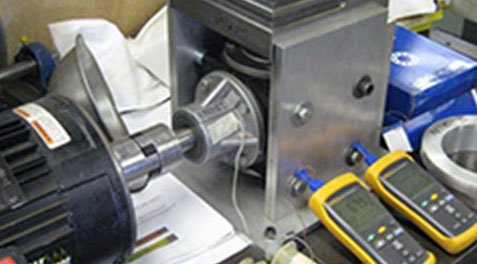

Centritec Seals has developed a unique, patented non-contact seal that utilizes centrifugal forces to pressurize the lubricating fluid entering a seal. This lubricant forms a pressurized barrier, that prevents additional lubricating fluid from entering the seal, while also pumping lubricant back into the housing containing the seal, the lubricating fluid, and operating components. The result is a reliable centrifugal shaft seal design that delivers long service life and low maintenance.
A centrifugal pressure seal is a type of non-contact mechanical seal that uses centrifugal force to create a pressurized barrier of lubricating fluid, effectively sealing rotating shafts without direct contact. This design minimizes wear, reduces heat generation, and maintains consistent lubrication, making it ideal for high-speed, demanding industrial applications.
In this article, our non-contact seal experts explain how centrifugal seals work, detailing how they function and the advantages they offer over traditional sealing methods like labyrinth or lip seals.
As shown in the demonstration video to the right, the inner race of a Centritec Seal and the shaft are rotating, while the shaft and the seal's outer race are stationary. The fluid entering the seal from the housing or sump (represented in blue) migrates into the passageway between the seal's outer race and inner race. The fluid moves through the passageway and eventually reaches the outer surface of the rotating inner race, where it is centrifugally forced outward to the inside of the rotating inner race fluid cavity, passing through the pumping disc. The fluid cavity is an integral part of the inner race and therefore rotates.
The fluid cannot splash or migrate axially in the fluid cavity and is forced to flow through the pumping disc thereby keeping the lubricating fluid in laminar flow. As the fluid cavity fills with lubricant, the lubricating fluid is pressurized by the rotating chamber's centrifugal forces and ultimately returns to the inlet path between the rotating chamber and the stationary outer ring by way of communication holes in the rotating chamber. This motion forces the fluid out of the seal and forms a pressurized barrier to entry. Additional fluid cannot enter the seal until the lubrication fluid is pumped from the cavity. This is a continual process, and the process will vary depending upon the lubrication oil sump height, the operating speed and the fluid viscosity.
The pressurized lubricating fluid can be channeled throughout the lubricant housing, which will keep bearings constantly lubricated and will ensure proper bearing lubrication, without relying on the splashing of rotating components.
The unique pumping action of a centrifugal pressure seal provides multiple operational advantages:
These benefits can extend bearing life, reduce maintenance intervals, and improve overall equipment reliability. Learn more about the benefits of centrifugal seal solutions from our experts.
Centritec’s non-contact centrifugal shaft seals are used in gearboxes, pumps, compressors, fan assemblies, and more. They perform exceptionally well in harsh environments, vertical shaft applications, and high-speed sealing systems where uptime and efficiency are critical. Explore more details about specific applications and view a case study about how Centritec Seals were effectively used in a circulation fan at a waste-to-energy plant.
Understanding how centrifugal seals work highlights the value in improving equipment longevity, reducing maintenance, and supporting high-performance operations across various industries. Whether you are designing new systems or upgrading existing ones, selecting the right sealing solution is critical for efficiency and reliability. Our experts are here to help.
Contact Centritec Seals for more information on our centrifugal seal manufacturer services, or to request a quote for your application.